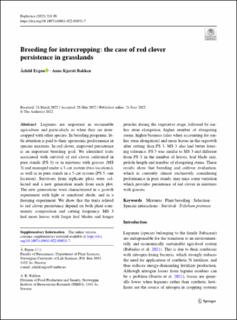| dc.contributor.author | Ergon, Åshild Gunilla | |
| dc.contributor.author | Bakken, Anne Kjersti | |
| dc.date.accessioned | 2022-10-07T11:41:34Z | |
| dc.date.available | 2022-10-07T11:41:34Z | |
| dc.date.created | 2022-08-08T14:07:00Z | |
| dc.date.issued | 2022-06-24 | |
| dc.identifier.citation | Euphytica. 2022, 218 . | en_US |
| dc.identifier.issn | 0014-2336 | |
| dc.identifier.uri | https://hdl.handle.net/11250/3024504 | |
| dc.description.abstract | Legumes are important in sustainable agriculture and particularly so when they are intercropped with other species. In breeding programs, little attention is paid to their agronomic performance in species mixtures. In red clover, improved persistence is an important breeding goal. We identified traits associated with survival of red clover cultivated in pure stands (PS 3) or in mixtures with grasses (MS 3) and managed under a 3-cut system (two locations), as well as in pure stands in a 5-cut system (PS 5, one location). Survivors from replicate plots were collected and a new generation made from each plot. The new generations were characterized in a growth experiment with light or simulated shade, and in a freezing experiment. We show that the traits related to red clover persistence depend on both plant community composition and cutting frequency. MS 3 had more leaves with larger leaf blades and longer petioles during the vegetative stage, followed by earlier stem elongation, higher number of elongating stems, higher biomass (also when accounting for earlier stem elongation) and more leaves in the regrowth after cutting than PS 3. MS 3 also had better freezing tolerance. PS 5 was similar to MS 3 and different from PS 3 in the number of leaves, leaf blade size, petiole length and number of elongating stems. These results show that breeding and cultivar evaluation, which is currently almost exclusively considering performance in pure stands, may miss some variation which provides persistence of red clover in mixtures with grasses. | en_US |
| dc.description.abstract | Breeding for intercropping: the case of red clover persistence in grasslands | en_US |
| dc.language.iso | eng | en_US |
| dc.publisher | Springer Nature | en_US |
| dc.rights | Navngivelse 4.0 Internasjonal | * |
| dc.rights.uri | http://creativecommons.org/licenses/by/4.0/deed.no | * |
| dc.title | Breeding for intercropping: the case of red clover persistence in grasslands | en_US |
| dc.title.alternative | Breeding for intercropping: the case of red clover persistence in grasslands | en_US |
| dc.type | Peer reviewed | en_US |
| dc.type | Journal article | en_US |
| dc.description.version | publishedVersion | en_US |
| dc.rights.holder | © The Author(s) 2022 | en_US |
| dc.source.pagenumber | 13 | en_US |
| dc.source.volume | 218 | en_US |
| dc.source.journal | Euphytica | en_US |
| dc.identifier.doi | 10.1007/s10681-022-03051-7 | |
| dc.identifier.cristin | 2041754 | |
| dc.relation.project | Norges forskningsråd: 225330 | en_US |
| dc.source.articlenumber | 98 | en_US |
| cristin.ispublished | true | |
| cristin.fulltext | original | |
| cristin.qualitycode | 1 | |

